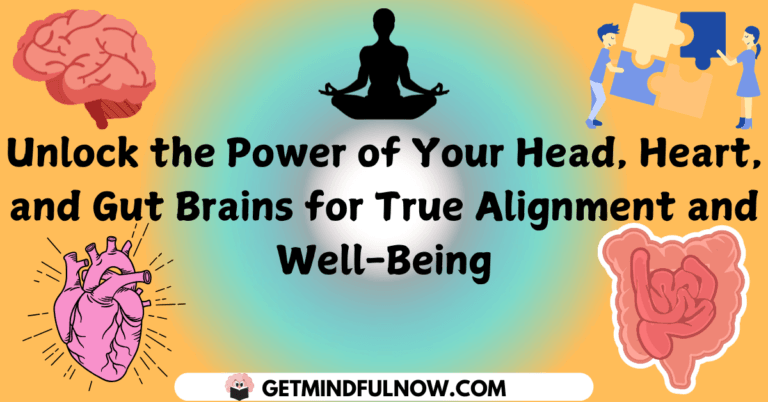You’ve probably heard the saying, “Trust your gut,” or maybe, “Follow your heart.” But did you know that these phrases aren’t just poetic metaphors? They’re rooted in real science. Inside your body, you have not one, but three brains: the head brain, the heart brain, and the gut brain. Each plays a vital role in your physical, emotional, and psychological health. What’s fascinating is how these three brains are energetically connected, creating a dynamic network that can either elevate or challenge your well-being.
Let’s dive into how these three brains work together and discover the one critical piece often overlooked by many discussions on this topic—your power to consciously align them for transformative results.
The Head Brain: Command Central
Your head brain, or central nervous system (CNS), is what most of us think of as “the brain.” It houses around 86 billion neurons, orchestrating complex thoughts, emotions, and behaviors. This brain processes sensory input, solves problems, and makes decisions. Yet, it’s not an island; it’s constantly in dialogue with your heart and gut.
For instance, studies from the University of California suggest that emotional stress can disrupt this dialogue, impairing decision-making and even causing physical symptoms like headaches. When your head brain is in a state of balance, it enhances your ability to think clearly, focus, and stay resilient under pressure.
The Heart Brain: The Emotional Compass
Your heart isn’t just a blood pump. Scientists at the HeartMath Institute discovered that the heart has its own neural network, often called the “heart brain.” This system can sense, feel, and even “think” independently. It’s deeply connected to your emotional experiences, releasing oxytocin—the “love hormone”—in response to positive feelings.
What’s more, the heart sends more signals to the brain than the brain sends to the heart. This means that your emotional state significantly impacts your thoughts and perceptions. When your heart rhythm is coherent (steady and balanced), it fosters feelings of calm and clarity, influencing your head brain to think more effectively.
Research published in the Frontiers in Psychology journal emphasizes the importance of cultivating heart coherence. Practices like gratitude journaling or focused breathing can bring your heart into a harmonious rhythm, which in turn improves your mental state.
The Gut Brain: Your Inner Compass
The gut, often called the “second brain,” houses the enteric nervous system (ENS). This system contains over 500 million neurons and produces 90% of the body’s serotonin—a neurotransmitter critical for mood regulation. The gut-brain axis connects the ENS with the CNS, forming a bidirectional communication highway.
Ever felt butterflies before a big event or experienced an upset stomach when stressed? That’s your gut brain reacting. Recent research from Johns Hopkins University reveals that an imbalanced gut microbiome can contribute to anxiety and depression. By nourishing your gut with fiber-rich foods, probiotics, and mindful eating habits, you’re not just improving digestion but also stabilizing your mood.
The Missing Link: Energetic Alignment
Now here’s the piece that’s often overlooked: the energetic alignment of your three brains. Most discussions focus on their physiological roles, but few dive into how you can actively harmonize these systems for holistic well-being. This isn’t just about better health; it’s about living in flow.
The secret lies in coherence—the state where your head, heart, and gut operate in sync. When aligned, these three brains create a powerful synergy that amplifies intuition, emotional resilience, and cognitive clarity. Think of coherence as tuning an orchestra. Each instrument (or brain) must play its part to create a harmonious melody.
How to Align Your Three Brains
Here’s where the magic happens. By engaging in practices that harmonize your three brains, you can unlock a state of coherence that transforms your physical, emotional, and psychological health. Let’s explore actionable steps:
1. Mindful Breathing
Deep, rhythmic breathing acts as a bridge between the three brains. Studies show that diaphragmatic breathing slows your heart rate, soothes your gut, and calms your mind. Try the 5-5-5 method: inhale for five seconds, hold for five seconds, and exhale for five seconds. Do this for ten minutes daily to create alignment.
2. Heart-Brain Meditation
Start by sitting comfortably and breathing to slow your brainwaves down and then start focusing on your heart. Imagine a warm, glowing light radiating from it. As you breathe, visualize this light connecting to your head and gut. This meditation has been shown to increase heart coherence and reduce stress hormones like cortisol.
3. Nourish Your Gut
Your gut thrives on diversity. Incorporate foods rich in probiotics (yogurt, kimchi) and prebiotics (onions, bananas). Avoid processed foods that can disrupt your gut-brain axis. Start working on difficult emotions from past and release them by meditating daily. Harvard research highlights how a healthy gut microbiome can enhance mood and cognitive function.
4. Practice Emotional Release
Negative emotions often block heart coherence. Journaling, therapy, or even a good cry can help release pent-up energy. Releasing emotional baggage allows you to access elevated states of being, aligning your three brains.
My Journey to Three-Brain Balance
Let me share something personal. As someone deeply invested in understanding and transforming my own life, I’ve been on a journey to create balance among my three brains. For years, I struggled with overthinking, emotional instability (because of negative beliefs)—my head brain often overshadowed the wisdom of my heart and gut. This led to chronic stress, multiple health diagnosis, and a feeling of disconnection.
Things began to shift when I started incorporating heart-brain coherence techniques. I would sit quietly every morning, placing my hand over my heart, and breathe deeply while visualizing gratitude. Over time, I noticed my emotions stabilizing, and my decision-making improved.
The real breakthrough came when I focused on my gut health. After learning about the gut-brain connection, I started eating more fermented foods and started inner healing work for releasing stuck emotions from past. The changes were remarkable. Not only did I feel lighter physically, but my mood also lifted. I could feel my intuition—my gut’s voice—gaining clarity.
Today, I’m far from perfect, but I’m learning to listen to all three brains. When faced with a challenge, I pause and ask: What does my head say? How does my heart feel? And what is my gut telling me? This practice has transformed how I approach life’s complexities, making me feel more aligned and empowered.
Imagine waking up every day with a sense of calm, clarity, and purpose. When your three brains are in alignment, you feel more in tune with yourself and the world around you. Decisions become intuitive, relationships deepen, and challenges feel manageable.
Take Sarah( a client I worked with), for instance. A busy entrepreneur, she often felt scattered and anxious. After learning about the three brains, she started practicing meditation everyday which was basically an activity for brain neuroplasticity . After a while it elevated her emotional, spiritual health and improving her gut health. Within weeks, she noticed increased focus, better sleep, and a newfound sense of confidence.
Final Thoughts
You are more powerful than you think. By understanding and aligning your three brains, you can unlock a level of health and happiness that goes beyond the ordinary. Start with small changes—a few minutes of breathing, a heart-focused meditation, or a gut-friendly meal. These actions may seem simple, but their ripple effects are profound.
Your head, heart, and gut are more than organs; they are gateways to your highest potential. The question is, are you ready to align them and step into the best version of yourself?








